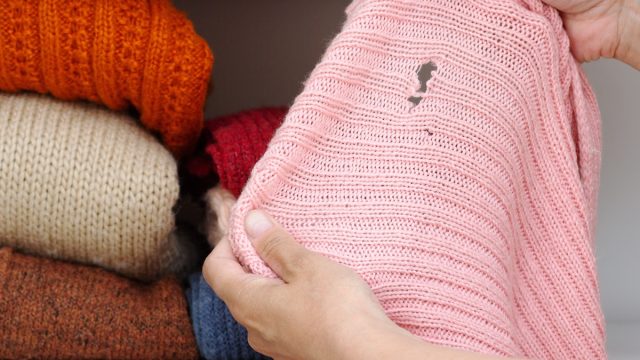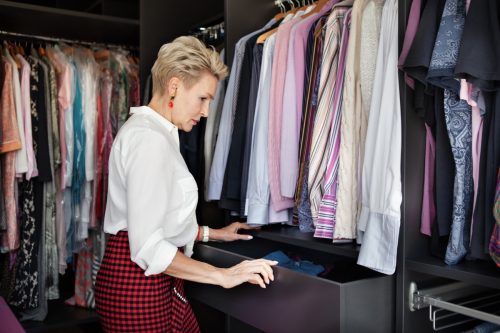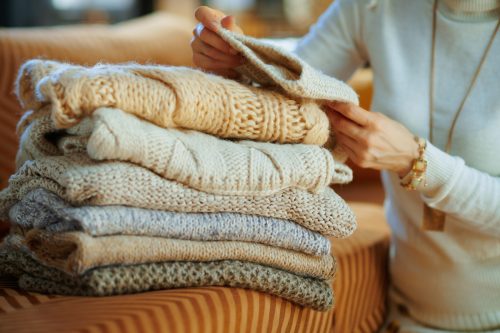6 Things Attracting Moths to Your Closet—And How to Get Rid of Them

There’s nothing worse than the sinking feeling that comes when you notice a pest in your home. If you have expensive clothes, the pest you fear most is likely moths. In their larva stage, these insects eat fibers of animal origin, such as wool, cashmere, silk, and fur (you know, all the priciest things in your wardrobe!). But the good news is that clothes moths are less common than ever due to an increase in dry cleaning and other sanitation measures. Still, you’ll want to take a few steps to ensure you’re not attracting them to your space. Ahead, exterminators outline the key things that attract moths to your closet and what you can do to avoid them.
RELATED: 6 Things You Should Never Store in Your Closet, According to Experts.
1
Clothes you never wear

As if you needed another reminder to do that closet cleanout, consider this: “Moths prefer dark, undisturbed places, so they typically attack items that are stored and unused for extended periods of time,” says Scot Hodges, entomologist and vice president at Arrow Exterminators. “Limiting stored items can be helpful, but if you can’t cut down on storage, you can deep clean, vacuum, and reduce clutter in storage areas a couple of times a year.”
That way, the moths have fewer places to hide. Add another layer of protection by storing your clothes in airtight bags, Hodges suggests.
2
Tightly packed clothing

Overcrowding can also be an issue. “When clothes are packed tightly together, air cannot circulate properly, creating a dark and humid environment that moths find appealing,” says Rich Mullins, exterminator and plumber at H20 Plumbing. “This type of environment provides an ideal breeding ground for moths to lay eggs and thrive.”
Hang your things loosely enough so there’s a bit of space between each garment, and don’t try to pack a ton of items onto each shelf. Again, regularly parsing through your things to see what you wear and what can be donated will make a world of difference in keeping critters away.
RELATED: 9 Cleaning Habits That Attract Spiders.
3
Unwashed secondhand items

According to Hodges, moths are not a common problem in modern homes, which means you’re most likely to encounter an infestation if you accidentally bring the pests home.
“Thus, one of the biggest cleanliness mistakes people make that attract moths to their clothes is simply not washing secondhand clothing, furniture, rugs, blankets, and other items made with textiles as soon as you bring them into your home,” he says. “Be sure to inspect these items carefully—they can be infested without your knowing—and wash or dry clean them as soon as possible.”
You might notice the moths as tiny caterpillars or see the telltale holes they eat in the items.
RELATED: 6 Foods in Your Kitchen That Are Bringing Mice Into Your Home.
4
Dirty laundry

Those overflowing piles of laundry on your closet floor can act like a buffet for moths, as can pet hair, which is another food source.
“Make sure you regularly clean any clothing or furniture your pet may shed on,” advises Hodges. You’ll also want to clean out the bottom of your hamper and crevices of your closet, where dust and pet hair can accumulate.
5
Natural fabrics

Natural fibers like wool, cashmere, fur, and silk are popular with many people—and, well, moths like them too.
“These materials provide moths with the nutrients they need to thrive during their larval stage,” says Mullins. “The textures and residual oils found in these fabrics make them ideal targets for moth larvae to feed on.”
On the flip side, synthetic materials like polyester and nylon are less attractive to pests because they lack nutrients and organic matter. That doesn’t mean you need to avoid natural fibers entirely—they’re some of the best quality materials for garments—just make sure you keep them clean or store them in air-tight bags, especially during the off-season when they may sit untouched for months.
For more home and pest tips sent directly to your inbox, sign up for our daily newsletter.
6
Other pests

If your closet has had other pest problems, then moths might find it especially attractive, as they can feed on animal nesting materials and carcasses.
“Take steps to keep critters out of your home, such as keeping spaces clean of food waste, sealing possible entry points, and minimizing clutter in your yard,” says Hodges.
If you do think you’ve spotted a clothes moth, you’ll want to call in a pro. “Homeowners should ensure an inspection and proper identification is made to confirm the problem is clothes moths and not carpet beetles, which are common feeders on the same type fabrics and fibers and can be more difficult to control,” says Hodges. “If control efforts fail, it will be advisable to consult with a reputable pest control company.” They’ll be able to get your closet back into top shape.